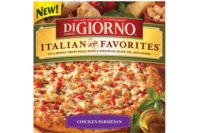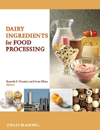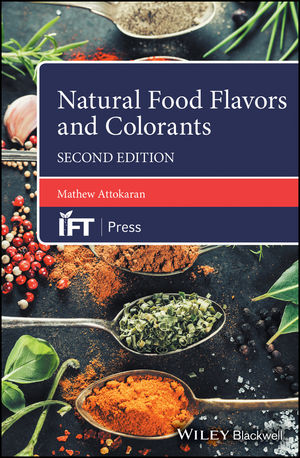A feast for the senses










What can bakers and snack producers expect to see in the way of seasonings and colors in the coming months? Leading flavor and color manufacturers say something old (classic flavors), something new (exotic fruits, sweet-and-salty pairings and saffron) and something blue (and green).
When Snack Food & Wholesale Bakery examined flavor and color trends last fall, leading flavor manufacturers cited spicy, bacon, smoke, caramel sea salt and indulgent as some of the up-and-coming flavors for baked goods and snacks. Color manufacturers, meanwhile, talked about colors to match ethnic flavors. A year later, grocers’ shelves are filled with products sporting these flavors and colors…and so are consumers’ shopping carts.
QualiTech Inc., Chaska, Minn., a manufacturer of standard and customized flavor inclusions and particulates, introduced a number of savory, sweet-and-savory and sweet flavors in the past year that are being used in muffins, waffles, cookies, bagels, and chips. Its savory offerings include French toast, natural-flavor bacon and maple bacon.
“Bacon makes everything better!” says Ron Heddleson, director of technical services. “We have a kosher, parève bacon inclusion with a much lower sodium content than the actual thing, and no trans-fat. We can also manipulate the intensity of the flavor to provide just the right impact for your product. Bacon is a way to introduce salt into a sweet application, adding richness and developing a much more complex and satisfying food product. Applewood, hickory-smoked and maple-cured bacon are popular flavor profiles right now.”
Caramel with sea salt is one of QualiTech’s recent sweet-and-savory introductions. “We observed the emergence of this flavor profile in coffee shops, and worked to translate it into an inclusion that could be used in a muffin,” Heddleson explains, adding that it’s being used in breads, muffins, cakes, bagels, tortilla chips, breading, biscuits, waffles, donuts, cereal and pretzels. “Caramel and sea salt inclusions can be formulated to provide a melted pocket of rich sweet caramel flavor that’s complemented by a salty impression.”
The company has also introduced a number of sweet flavors (Dreamsicle, birthday cake, vanilla icing, honey, jumble berry and Clementine) and exotic fruit flavors (tart cherry, acai, pomegranate, and mango) in the past 12 months.
Sweet and fruity…
Sweet and fruit flavors also appeared on Sensient Flavors LLC’s 2013 flavor prediction list, which featured alderwood smoke, blue honeysuckle berry, cloudberry, dandelion honey, French toast, ghost pepper, pawpaw, peanut butter and jelly, Speculoos and za’atar. The annual list is compiled using Sensient’s Trend to Taste program, a proprietary, predictive process that filters trends from the broad consumer macro level down to finished concepts that best demonstrate each flavor.
“As a result of this trend research, Sensient has developed a platform dedicated to uncovering and developing flavors inspired from all-natural, true-to-type varietal fruits,” says Teresa Olah, marketing manager, flavor systems, at the Indianapolis-based company’s Hoffman Estates, Ill., facility. “The platform currently includes a portfolio of apple and just recently-released cherry flavors. These flavors allow manufacturers to create products with unique profiles suitable for a variety of food and beverage applications.”
The apple flavors include Braeburn, Crispin, Fuji, Gala, Golden Delicious, Granny Smith, Honeycrisp, Jonathan, McIntosh and Red Delicious, while Attika, Black Cherry, Duke, Maraschino, Morello and Wild Cherry are part of the cherry flavor range.
Omaha, Neb.-based Spicetec Flavors & Seasonings, meanwhile, has been experiencing the sweeter side of flavors. “We’re constantly developing new flavors in response to customers’ new developments,” says Jerome Lombardo, senior principal flavorist. “What we’re seeing in the snack area, particularly in ready-to-eat snacks, is a lot more requests for sweet flavors, such as cinnamon types, candy types, chocolates and things like that.”
As for baked goods flavors, “I can’t say that I’ve seen anything different from what I’ve seen in the past,” Lombardo says. “We’re seeing a lot of cake-type flavors—birthday cake and ice cream, red velvet cake. We’re seeing more demand for the sweet indulgence—S’mores, for example. It’s not new, but we’re seeing more demand for that type of flavor.”
…And nutty, cheesy and spicy
Launched at the Institute of Food Technologists’ (IFT) Annual Meeting and Food Expo in July, Maverick Innovations LLC, Hillsborough, N.C., a sister company to U.K.-based Omegas Ingredients, unveiled new flavors in several ranges this past year.
“We introduced new natural flavors, including our ‘nut-free nut’ range, which is a mixture of natural extracts and natural flavoring substances,” says CEO Steve Pearce. “They include almond, hazelnut, chocolate and hazelnut, white chocolate and hazelnut and peanut. We also introduced a natural pecan and maple syrup flavor this year. It’s proving very popular with snack food and baked goods manufacturers in the U.S. the market.”
The company is offering a new range of spray, crystallized, real Belgian chocolate in milk, dark and white chocolate varieties. “It’s an ingredient that allows snack food and baked goods manufacturers to use less chocolate for a bigger flavor impact as the chocolate is frozen into tiny crystals, which gives a greater total surface area for the chocolate to carry the flavor in products,” Pearce explains.
Maverick Innovations is working on real wasabi flavor and cheese flavors, which are popular for potato chips and other snack foods.
Cheesy, sweet and chocolate are flavors being requested by Carolina Ingredients’ customers, says Mike Cantore, vice president of sales for the Rock Hill, S.C., company, whose seasonings are used to make baked snacks, puffs, extruded snacks, chips and more.
Spicy flavors continue to be hot, too. “People have asked for a lot of hot seasonings lately,” Cantore says. “They’re always the trend. We’ve seen more of the jalapeno cheddars, the chipotle ranch, the wasabi. Siracha’s been a huge buzzword these days. Everybody knows the rooster sauce.”
Stepping outside of ‘normal’
The company has also been seeing what it calls “one step outside of normal,” says Cantore. “People usually buy what they’re familiar with—sour-cream-and-onion, salt-and-vinegar and, obviously, plain salt on chips and snacks. Now that the economy is losening up, people are spending more money and stepping out a bit. So you’ll see something like a salt and malt vinegar and sour cream and French onion, which is basically sour cream and onion with a bit of a twist.”
Kancor North America Inc.’s new fried onion, roasted garlic, roasted onion, black cumin and Szechwan pepper flavors are also putting a new twist on chips and fries and giving consumers something to shout about. “With respect to flavors, we find that today’s consumers have a discerning palate,” says Sanjaya Mariwala, managing director at the Morristown, N.J.-based natural ingredients company. “They want excitement and innovation when it comes to taste. Even while experiencing nostalgic or retro flavors, customers are looking for a new twist on the classics.”
Like other flavor manufacturers, Wixon Inc. continues to see trends in natural, fruity and hot flavors, say Jeanne Meeder, industrial ingredients and consumer products director and Mel Mann, director of flavor innovation, at the St. Francis, Wis., seasoning and flavor systems solutions manufacturer. Manufacturers are looking to these new flavors and others to differentiate their offerings in potato chips, tortilla chips, extruded snacks and pretzels.
On the flavor horizon
With so many flavors currently available to bakers, snack producers and consumers, it’s hard to conceive that there could be more on the horizon…but there are, say flavor specialists.
“Some of the next big flavors that we are seeing are more on the savory side, like pumpkin, ash (charred food, fire and smoke), sweet potato and green tea,” Heddleson says. “On the sweet side, [there’s] caramel, key lime, orange, and chocolate and chili peppers.”
Olah says sour flavors are on-trend and, when combined with spicy ingredients, will be the next big thing next to sweet-and-salty. As an example, she cites black lemon, a spice used in the Middle East that tastes sour and citrusy like a lime and is somewhat smoky, but lacks the sweetness of fresh limes.
“[Consumers also] want real ingredients and traditional spices,” she continues. “Demerara sugar, produced on the island of Mauritius, [is] a type of unrefined sugar with a rich, creamy, molasses-like flavor [that] will be seen enhancing baked goods.”
Wixon’s Meeder and Mann see continued interested in extremely intense flavors, especially varietal or regional pepper heat blends and fusion of sensory experiences like sweet with sour, smoked with herbs or cheese with spicy, aimed at adults. The pair also cites extreme tastes like sour, salty or bitter aimed at kids and the continued use of ethnic regional associations for flavors beyond simply Asian, Tex-Mex, Mediterranean, etc., as upcoming flavor trends.
“[Mixing] spices with fruits and florals is also becoming more interesting and something you may see changing in products like cakes and cookies in particular,” says Pearce. “Asian flavors like lemongrass with geranium notes would be a typical idea, and things like the use of rose in Turkish delight and northern African dishes is already well-known.”
Underused ingredients like saffron may also begin appearing in baked goods and snack foods. “There’s a misconception among some producers who don’t use it that saffron is expensive,” Pearce explains. “[So they] automatically stay away from it without trying it and recognizing what an interesting product it is from a flavor point of view. However, it’s now affordable for food manufacturers, and there’s a lot of research coming through now showing how important saffron is for satiety and how it can help people lose weight. Its use in baked goods and snack food is only likely to increase.”
Cantore and Lombardo say that what’s not in flavors and colors is a growing trend, too. “We’re going to see a trend toward nongenetically modified organisms (GMO) as a whole,” says Cantore. “I’m already hearing a lot of questions about nonGMO—‘What do we need to do?’ and ‘Can you make the seasoning that you’re currently making into nonGMO?’”
“About 10 years ago, we started getting more requests for cleaner labels without chemical-sounding names in the ingredients statement,” says Lombardo. “That trend’s continuing. Lately, we’re starting to get a lot more requests for nonGMO and gluten-free. With a lot of states looking at their own nonGMO legislation, a lot of companies are starting to look at how they can make their products nonGMO.”
Color their world
Just as people are looking for snacks and baked goods with new, unconventional or globally-inspired flavors, they’re also giving a nod to more colorful products, such as red velvet cake, pastel macaroons and purple tortilla chips. Thanks to recent introductions by several leading food and beverage color manufacturers, bakers and snack producers will be able to bring even more color to consumers’ mealtimes.
St. Louis-based Sensient Colors LLC recently launched the industry’s first stable natural blues and greens approved for use in the U.S. in beverages and foods, including snacks and baked goods. “These new natural colors fill the most significant gap in the natural color spectrum,” says Mike Geraghty, president, Color Group, Sensient Technologies Corp., St. Louis.
Developed through extensive R&D, the sources of natural blue and green lines are derived from spirulina and vegetable and fruit juices. The colors are kosher- and halal-certified, contain no GMOs and have proved to be extremely stable in light and heat testing.
The bright, natural blue range can replicate a certified color or offer natural blue tones ranging from blueberry to sky blue. The natural green offerings range from vibrant emerald to clean mint. The extended natural purple range offers intense grape to soft pastel lavenders. Because of their broad pH stability range (2.5-7.0), they can be used in all applications, such as beverage, dairy, confection, baking and processed foods.
“Combining these new bright and bold blue-based shades with our expanded shade ranges of reds, oranges and yellow created by our Advanced Emulsion Technology platform launched earlier this year allows us to close the gap between natural color science and certified color technology to finally create a complete natural color spectrum,” Geraghty says.
Not just singing the blues
QualiTech now also offers natural blue colors in its inclusions. “Upcoming trends in colors will likely include an increase in the use of natural blue colors, which have recently received [Food and Drug Administration] approval for confectionery applications and will likely be approved for other categories within the food industry,” Heddleson says.
Shades of lavender, pineapple, mango and black currant were introduced this year by Kancor North America, says Mariwala. “Each year, we continue to see a growth of more than 25% when it comes to our natural colors,” he says. “The Southampton Six study on dyes had a significant impact on the rise in [consumer] demand of natural colors.” (The 2007 British study linked six colors to hyperactivity in children.)
When it comes to baked goods, Kancor’s colors are used mostly in cakes and pastries. “We believe that within the next two to three years, the trend will shift to coloring foods,” Mariwala says.
Bakers and snack manufacturers know that for most people food is about more than just eating. It’s about experiencing new cultures, enjoying a meal with family and friends or savoring an indulgent treat. Flavors and colors—traditional, exotic, still-to-be-discovered—enable food producers to create products that feed consumers’ senses as well as nourish their bodies.
Looking for a reprint of this article?
From high-res PDFs to custom plaques, order your copy today!














